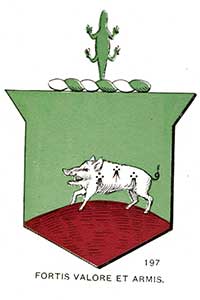The O’Hanlon Family

(Crest No. 197. Plate 13.)
THE O’Hanlon family is descended from Milesius, King of Spain, through the Heremon line, and belonged to the Hy Many tribe. The founder of the family was Colla da Crioch, son of Colla Vais, or Huais, King of Ireland, A. D. 315. The ancient name was Hanluan, signifying “ Very Strong.”
The O’Hanlons took their name from Hanluan, Chief of Hy Rieth Thire. The head of the sept bore the title of Chief of Hy Rieth Thire.
The possessions of the O’Hanlons were located in the present County of Armagh, and comprised the barony of Orior.
The O’Hanlons held the office of hereditary regal standard bearers of Ulster. They maintained their independence and held their possessions down to the reign of Elizabeth, when Armagh was formed into a county, A. D. 1586, by the Lord Deputy, Sir John Perrott.
James the First granted to Sir Oliver St. John the castle and the estate forfeited by the O'Hanlons, on the site of whose residence stands the Duke of Manchester’s Castle. About half way between Tandragee and Scarva is the graveyard which holds the ashes of the heroic Redmond O’Hanlon. Glen Fluck Castle, created by Colonel Monck, afterward Duke of Albemarle, is about two miles from Redmond’s resting place.
In the wars of resistance to the English invasion the O’Hanlons bore a conspicuous part. They were among the chief supporters of Hugh O’Neill in his long struggle against Elizabeth, and they were at all times and in all places distinguished for their courage and fidelity. A memorable member of this sept was Redmond O’Hanlon, the Rapparee. After the surrender of Limerick, when the bulk of the Irish army entered the service of Louis the Fourteenth, a multitude of the old soldiers of the Boyne, Aughrim and Limerick preferred remaining in the country at the risk of fighting for their daily bread, and with them some gentlemen loath to part with their estates or their sweethearts. “The English army and the English law,” says Duffy, “drove them by degrees to the hills, where they were long a terror to the new and old settlers from England, and a secret pride and comfort to the trampled peasantry, who loved them even for their excesses. It was all they had left to take pride in.”
Of these Rapparees, or guerrilla defenders of an oppressed and plundered people, Redmond, or Rory O’Hanlon, was the most celebrated. His name and exploits are still vividly remembered in the traditions of the localities where during life he was the terror of the English and Scotch adventurers. One of his favorite methods of retaliation on the despoilers was to rob them, and then distribute the booty among the rightful owners of the Irish lands they had seized. His exploits would fill a volume and read like extravagant romance. He was betrayed by his foster-brother, in the County Down, April, 1681, and his head was spiked over the jail in Downpatrick.
The Rapparees in those days in the north were the only guard to stand between the despoiled Irish peasantry and their would-be exterminators; and the vengeance of the Rapparees, swift and keen, if it did not inspire the oppressor with a sense of justice, moved him with a wholesome dread of the results of continued oppression and repeated outrage. The Rapparees derived that appellation from the rapier, or half pike, which was their principal weapon, besides the skian, or short sword.
“Oh, never fear for Ireland, for she has sogers still,
For Rory’s boys are in the wood, and Remy’s on the hill;
And never had poor Ireland more loyal hearts than these—
May God be good and kind to them, the faithful Rapparees!
The fearless Rapparees!
The jewel were you, Rory, with your Irish Rapparees!
“Oh, black’s your heart, Clan Oliver, and cowlder than the clay,
Oh, high’s your head, Clan Sassenach, since Sarsfield’s gone away!
It’s little love you bear to us for sake of long ago,
But howld your hand, for Ireland still can strike a deadly blow—
Can strike a mortal blow—
Och-dhar-a-Chreesth, ’tis she that still could strike the deadly blow!
“The master’s bawn, the master’s seat a surly bodagh fills;
The master’s son, an outlawed man, is riding on the hills,
But God be praised, that round him throng as thick as summer bees,
The sword that guarded Limerick wall—his loyal Rapparees!
His loving Rapparees!
Who dare say no to Rory Oge, with all his Rapparees?
“Black Billy Grimes of Latnamard he racked us long and sore—
God rest the faithful hearts he broke! we’ll never see them more!
But I’ll go bail he’ll break no more, while Truagh has gallows-trees,
For why? he met one lonesome night, the fearless Rapparees!
The angry Rapparees!
They never sin no more, my boys, who cross the Rapparees!”
Several of the O’Hanlons went to France after the fall of Limerick and served in the Irish Brigade. One of them, a Captain in Roth’s Regiment, was wounded at Fontenoy.
